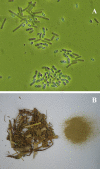Can transgenic maize affect soil microbial communities?
- PMID: 17009863
- PMCID: PMC1584322
- DOI: 10.1371/journal.pcbi.0020128
Can transgenic maize affect soil microbial communities?
Abstract
The aim of the experiment was to determine if temporal variations of belowground activity reflect the influence of the Cry1Ab protein from transgenic maize on soil bacteria and, hence, on a regulatory change of the microbial community (ability to metabolize sources belonging to different chemical guilds) and/or a change in numerical abundance of their cells. Litter placement is known for its strong influence on the soil decomposer communities. The effects of the addition of crop residues on respiration and catabolic activities of the bacterial community were examined in microcosm experiments. Four cultivars of Zea mays L. of two different isolines (each one including the conventional crop and its Bacillus thuringiensis cultivar) and one control of bulk soil were included in the experimental design. The growth models suggest a dichotomy between soils amended with either conventional or transgenic maize residues. The Cry1Ab protein appeared to influence the composition of the microbial community. The highly enhanced soil respiration observed during the first 72 h after the addition of Bt-maize residues can be interpreted as being related to the presence of the transgenic crop residues. This result was confirmed by agar plate counting, as the averages of the colony-forming units of soils in conventional treatments were about one-third of those treated with transgenic straw. Furthermore, the addition of Bt-maize appeared to induce increased microbial consumption of carbohydrates in BIOLOG EcoPlates. Three weeks after the addition of maize residues to the soils, no differences between the consumption rate of specific chemical guilds by bacteria in soils amended with transgenic maize and bacteria in soils amended with conventional maize were detectable. Reaped crop residues, comparable to post-harvest maize straw (a common practice in current agriculture), rapidly influence the soil bacterial cells at a functional level. Overall, these data support the existence of short Bt-induced ecological shifts in the microbial communities of croplands' soils.
Conflict of interest statement
Figures





References
-
- MacIntosh SC, Stone TB, Sims SR, Hunst PL, Greenplate JT, et al. Specificity and efficacy of purified Bacillus thuringiensis proteins against agronomically important insects. J Invert Pathol. 1990;56:258–266. - PubMed
-
- Gould F. Sustainability of transgenic insecticidal cultivars: Integrating pest genetics and ecology. Annu Rev Entomol. 1998;43:701–726. - PubMed
-
- Hillbeck A, Moar WJ, Pusztai-Carey M, Filippini A, Bigler F. Toxicity of Bacillus thuringiensis Cry1Ab toxin to the predator Chrysoperla carnea (Neuroptera: Chrysopidae) Environ Entomol. 1998;27:1255–1263.
Publication types
MeSH terms
Substances
LinkOut - more resources
Full Text Sources

